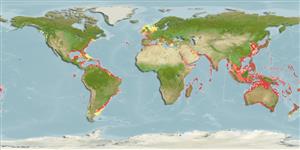Polychaeta |
Terebellida |
Terebellidae
Environment: milieu / climate zone / depth range / distribution range
Ecology
Reef-associated; brackish; depth range 10 - 75 m (Ref. 112705). Tropical
Indo-Pacific and Western Central Atlantic. Tropical and subtropical.
Length at first maturity / Size / Weight / Age
Maturity: Lm ? range ? - ? cm Max length : 25.0 cm BL male/unsexed; (Ref. 78042)
Inhabits Halodule wrightii beds (Ref. 83353). Also found in tide pools, deep estuarine channels and rubble in bays and seas. In protected areas where organic detritus is substantial and frequently replenished. Builds tube from sand and gravel or simply protect their body within vertical holes or in reef crevices (Ref. 107245). Sessile tentaculate suspension and surface deposit feeder (Ref. 125928).
Life cycle and mating behavior
Maturity | Reproduction | Spawning | Eggs | Fecundity | Larvae
Members of the class Polychaeta are mostly gonochoric (sexual). Mating: Females produce a pheromone attracting and signalling the males to shed sperm which in turn stimulates females to shed eggs, this behavior is known as swarming. Gametes are spawned through the metanephridia or body wall rupturing (termed as "epitoky", wherein a pelagic, reproductive individual, "epitoke", is formed from a benthic, nonreproductive individual, "atoke"). After fertilization, most eggs become planktonic; although some are retained in the worm tubes or burrowed in jelly masses attached to the tubes (egg brooders). Life Cycle: Eggs develop into trocophore larva, which later metamorph into juvenile stage (body lengthened), and later develop into adults.
Salazar-Vallejo, S.I. 1996 Lista de species y bibliografía de Poliquetos (Polychaeta) del Gran Caribe. Anales Inst. Biol. Univ. nac. Autón, México, Ser. Zool. 67(1):11-50. (Ref. 7866)
IUCN Red List Status
(Ref. 130435: Version 2025-1)
CITES status (Ref. 108899)
Not Evaluated
Not Evaluated
Threat to humans
Human uses
| FishSource |
Tools
More information
Population dynamicsGrowthMax. ages / sizesLength-weight rel.Length-length rel.Length-frequenciesMass conversionAbundance PhysiologyOxygen consumption
Human RelatedStamps, coins, misc.
Internet sources
Estimates based on models
Preferred temperature
(Ref.
115969): 18.5 - 28.3, mean 26.4 (based on 1642 cells).
Fishing Vulnerability
Low vulnerability (13 of 100).
Price category
Unknown.
